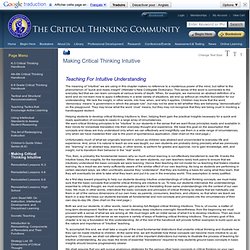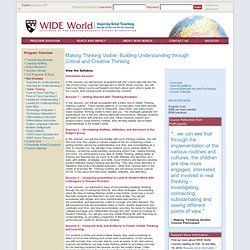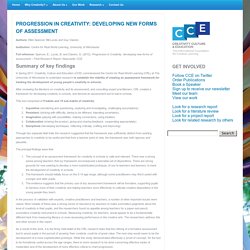

Making Critical Thinking Intuitive. Teaching For Intuitive Understanding The meaning of “intuitive” we are using in this chapter makes no reference to a mysterious power of the mind, but rather to the phenomenon of “quick and ready insight” (Webster’s New Collegiate Dictionary).

This sense of the word is connected to the everyday fact that we can learn concepts at various levels of depth. When, for example, we memorize an abstract definition of a word and do not learn how to apply it effectively in a wide variety of situations, we end up without an intuitive foundation for our understanding. We lack the insight, in other words, into how, when, and why it applies. Children may know that the word ‘democracy’ means “a government in which the people rule”, but may not be able to tell whether they are behaving “democratically” on the playground. Studies on Multitasking Highlight Value of Self-Control. Sowing Failure, Reaping Success: What Failure Can Teach. Mark Humphrey/Associated PressBill Belichick, coach of the New England Patriots, moments before losing to the Giants, 21-17, in Super Bowl XLVI in February.

When Have You Ever Failed at Something? What Happened as a Result? We pose these questions for students to answer as part of thinking about the broad theme of “failure”: how it is defined, what it means and what it can lead to. Everyone grapples with failure, even (or maybe especially) tremendously successful people. Ten Ways to Teach Innovation - San Rafael, CA. WIDE World - Program Overview - Our Courses - Making Thinking Visible. View the Syllabus In this session you will become acquainted with the course web site and the role of instructors, coaches and learners in WIDE World courses.

You will meet your fellow course participants and learn about each other’s goals for the course, their backgrounds and leadership contexts. In this session, you will get acquainted with a basic tool of Visible Thinking, ‘thinking routines’. These simple patterns of conversation (see-think-wonder, claim-support-question, circle of viewpoints, step inside, and many more) make students’ thinking visible to them and you. The strategies generate rich explorations ‘out of the box’ without elaborate introductions, although students get better at them with practice over time.
In this session, you will become familiar with more thinking routines. Socratic Questioning. Techniques > Questioning > Socratic Questions Conceptual | Assumptions | Rationale | Viewpoint | Implications | Question | See also Socrates was one of the greatest educators who taught by asking questions and thus drawing out answers from his pupils ('ex duco', means to 'lead out', which is the root of 'education').

Sadly, he martyred himself by drinking hemlock rather than compromise his principles. Bold, but not a good survival strategy. But then he lived very frugally and was known for his eccentricity. Here are the six types of questions that Socrates asked his pupils. The overall purpose of Socratic questioning, is to challenge accuracy and completeness of thinking in a way that acts to move people towards their ultimate goal.
Conceptual clarification questions Get them to think more about what exactly they are asking or thinking about. Why are you saying that? Probing assumptions What else could we assume? Probing rationale, reasons and evidence Why is that happening? See also. CCOT_Chapter%201_V4. www.oecd.org/edu/ceri/50153675.pdf. www.creativitycultureeducation.org/wp-content/uploads/Progression-in-Creativity-Final-Report-April-2012.pdf. Progression in Creativity: developing new forms of assessment. Posted on 24 Apr, 2012 Authors: Ellen Spencer, Bill Lucas and Guy Claxton Institution: Centre for Real World Learning, University of Winchester Full reference: Spencer, E., Lucas, B. and Claxton, G. (2012).

Progression in Creativity: developing new forms of assessment – Final Research Report. Newcastle: CCE Summary of key findings In Spring 2011, Creativity, Culture and Education (CCE) commissioned the Centre for Real-World Learning (CRL) at The University of Winchester to undertake research to establish the viability of creating an assessment framework for tracking the development of young people’s creativity in schools.
After reviewing the literature on creativity and its assessment, and consulting expert practitioners, CRL created a framework for developing creativity in schools, and derived an assessment tool to trial in schools. This tool comprised of 5 habits and 15 sub-habits of creativity: The principal findings were that: